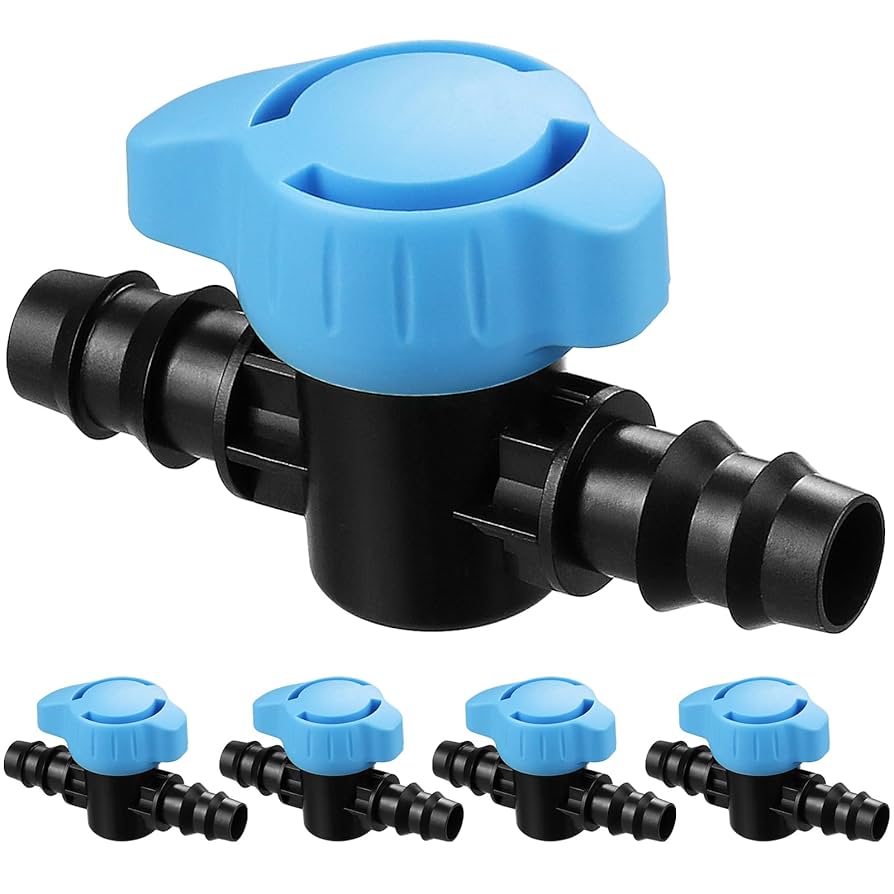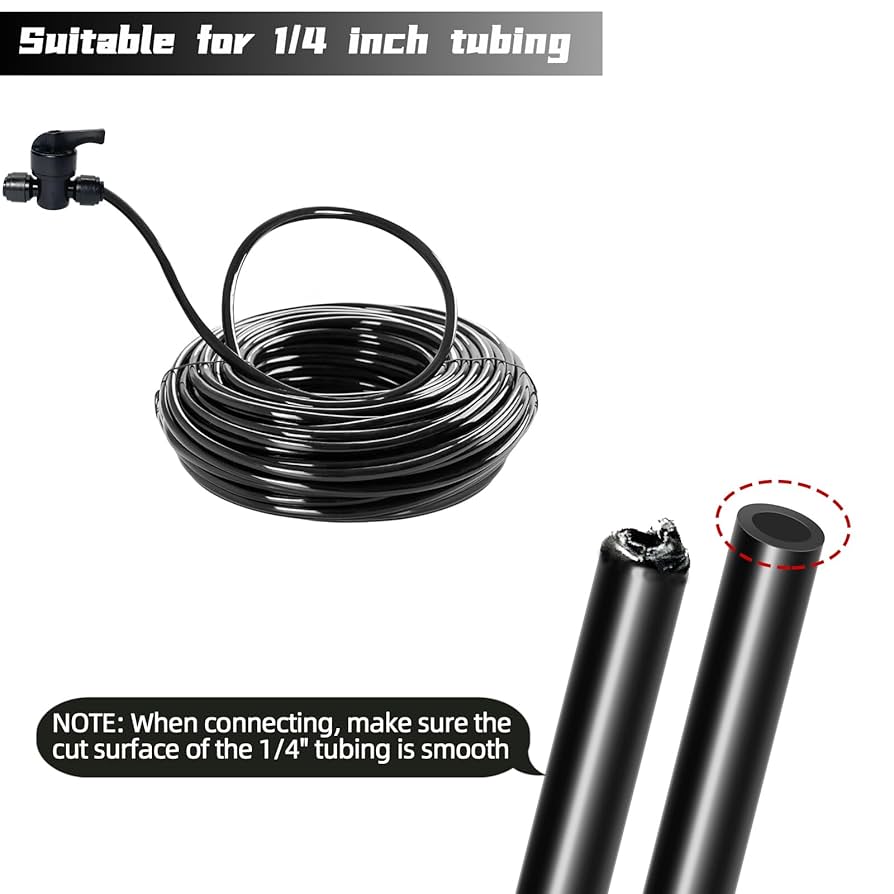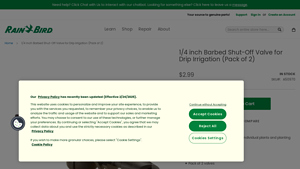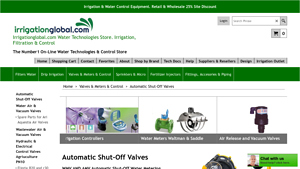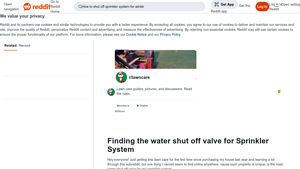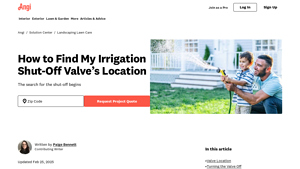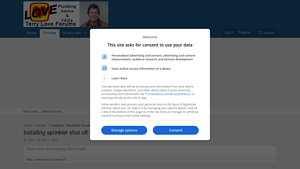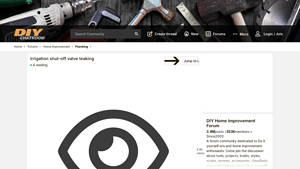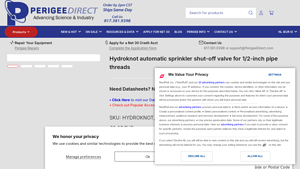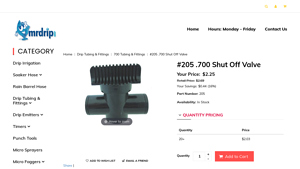Introduction: Navigating the Global Market for irrigation cut off valve
In an increasingly competitive global market, sourcing high-quality irrigation cut-off valves poses a significant challenge for international B2B buyers. As agricultural demands evolve across regions, particularly in Africa, South America, the Middle East, and Europe, the need for reliable and efficient water management solutions becomes paramount. This guide aims to demystify the complex landscape of irrigation cut-off valves, offering insights into various types, applications, and the latest technologies available in the market.
We will explore essential aspects such as supplier vetting processes to ensure quality and reliability, cost considerations that impact purchasing decisions, and the diverse applications of these valves in agricultural and landscape irrigation systems. By providing a thorough analysis of these components, this guide equips buyers with the knowledge needed to make informed decisions tailored to their specific operational needs.
Whether you are navigating the intricacies of bulk procurement or seeking innovative solutions to enhance your irrigation efficiency, this comprehensive resource empowers you to identify and secure the most suitable irrigation cut-off valves for your business. With actionable insights and expert guidance, you can optimize your irrigation systems, reduce water waste, and ultimately improve your agricultural productivity.
Understanding irrigation cut off valve Types and Variations
| Type Name | Key Distinguishing Features | Primary B2B Applications | Brief Pros & Cons for Buyers |
|---|---|---|---|
| Barbed Shut-Off Valve | Compact design, barbed ends for easy insertion into tubing | Drip irrigation systems, residential gardening | Pros: Cost-effective, easy installation; Cons: Limited pressure handling. |
| Automatic Shut-Off Valve | Automatically shuts off water based on preset volume | Agricultural irrigation, large-scale operations | Pros: Saves water, reduces manual labor; Cons: Higher initial investment. |
| Pressure Regulating Valve | Maintains consistent pressure to prevent overwatering | Commercial landscaping, golf courses | Pros: Enhances system efficiency; Cons: Requires regular maintenance. |
| Ball Valve | Simple on/off mechanism, durable construction | Industrial irrigation, water supply systems | Pros: Reliable and robust; Cons: Manual operation may be inconvenient. |
| Check Valve | Prevents backflow, ensuring one-way water flow | Wastewater management, irrigation systems | Pros: Protects system integrity; Cons: Can be prone to clogging. |
What are the Characteristics of Barbed Shut-Off Valves?
Barbed shut-off valves are designed for drip irrigation applications, allowing for straightforward control of water flow to individual plants or sections of a garden. These valves typically feature 1/4-inch barbed ends that securely fit into drip tubing, preventing leaks. Their compact size and affordability make them ideal for small-scale operations or residential gardening. When purchasing, consider the valve’s UV resistance and durability, especially for outdoor applications in varied climates.
How Do Automatic Shut-Off Valves Enhance Efficiency?
Automatic shut-off valves are engineered to deliver a precise volume of water before shutting off, making them suitable for agricultural and large-scale irrigation systems. These valves operate without electricity, relying on a simple mechanical design, which enhances reliability and ease of installation. Buyers should evaluate the valve’s accuracy and materials to ensure longevity in diverse environmental conditions. Although they represent a higher upfront cost, the water conservation benefits can lead to significant savings over time.
Why Choose Pressure Regulating Valves for Commercial Use?
Pressure regulating valves are essential in maintaining a consistent water pressure throughout irrigation systems, preventing issues such as overwatering or system damage. Commonly used in commercial landscaping and golf courses, these valves help optimize water usage and enhance plant health. When considering a purchase, it is important to assess the valve’s pressure rating and maintenance requirements, as these factors can influence overall system performance.
What Makes Ball Valves a Reliable Choice?
Ball valves offer a straightforward on/off mechanism, making them a popular choice for industrial irrigation and water supply systems. Their durable construction ensures long-lasting performance under various conditions. Buyers should consider the valve’s size and material compatibility with their existing systems. While ball valves are reliable, the necessity for manual operation might be a drawback in automated systems.
How Do Check Valves Protect Irrigation Systems?
Check valves are critical components in irrigation systems, preventing backflow and ensuring that water flows in one direction. They are particularly useful in wastewater management and can be integrated into various irrigation setups. When selecting a check valve, it is essential to consider its design and susceptibility to clogging, as these factors can affect system efficiency. Although they provide crucial protection, regular maintenance may be necessary to ensure optimal functionality.
Key Industrial Applications of irrigation cut off valve
| Industry/Sector | Specific Application of Irrigation Cut Off Valve | Value/Benefit for the Business | Key Sourcing Considerations for this Application |
|---|---|---|---|
| Agriculture | Drip Irrigation Systems | Optimizes water usage, improving crop yield | Durability, UV resistance, compatibility with tubing |
| Landscaping & Horticulture | Watering Control in Parks and Gardens | Prevents overwatering, enhances plant health | Size, ease of installation, maintenance requirements |
| Municipal Water Management | Control of Water Supply in Urban Areas | Efficient resource management, reduced waste | Compliance with local regulations, flow rate specifications |
| Greenhouse Operations | Individual Plant Watering Management | Tailored moisture levels for diverse plants | Precision in flow control, resistance to chemicals |
| Industrial Facilities | Process Water Control | Minimizes downtime, enhances operational efficiency | Robust design, pressure ratings, automated options |
How is the Irrigation Cut Off Valve Used in Agriculture?
In the agricultural sector, irrigation cut off valves are essential components of drip irrigation systems. They allow farmers to control the flow of water to specific areas, optimizing water usage and preventing over or under-watering of crops. This precision irrigation not only conserves water but also enhances crop yield and quality. International buyers, particularly in regions like Africa and South America, should consider the durability and UV resistance of these valves, as they are exposed to harsh environmental conditions.
What Role Do Irrigation Cut Off Valves Play in Landscaping & Horticulture?
In landscaping and horticulture, irrigation cut off valves help manage water distribution in parks, gardens, and green spaces. By enabling precise control over watering schedules and quantities, these valves prevent overwatering, which can lead to plant diseases and root rot. Buyers should focus on the valve’s size and ease of installation, as well as its maintenance requirements, ensuring compatibility with existing irrigation systems.
How Do Municipal Water Management Systems Utilize Irrigation Cut Off Valves?
Municipal water management relies on irrigation cut off valves to regulate water supply in urban areas. These valves play a critical role in efficient resource management, allowing municipalities to monitor and control water usage effectively. This helps in reducing waste and ensuring that water resources are allocated appropriately. When sourcing these valves, compliance with local regulations and specifications on flow rates are crucial considerations for international buyers.
In What Ways Are Irrigation Cut Off Valves Beneficial for Greenhouse Operations?
Greenhouses often use irrigation cut off valves to manage water delivery to individual plants, catering to their specific moisture needs. This tailored approach not only maximizes plant health but also conserves water, making it a sustainable choice for growers. Buyers in this sector should prioritize precision in flow control and the valve’s resistance to chemicals used in fertilizers and pesticides, ensuring compatibility with their cultivation practices.
How Do Industrial Facilities Implement Irrigation Cut Off Valves?
In industrial facilities, irrigation cut off valves are used to control process water, ensuring that operations run smoothly without interruptions due to water flow issues. These valves minimize downtime by providing reliable water management solutions. When sourcing for industrial applications, buyers should look for robust designs that can withstand high pressure and consider automated options for enhanced control and efficiency.
3 Common User Pain Points for ‘irrigation cut off valve’ & Their Solutions
Scenario 1: Difficulty in Controlling Water Flow for Diverse Plant Needs
The Problem: Many B2B buyers, especially those managing large agricultural operations or landscaping projects, face the challenge of providing varying water needs for different plant species. A single irrigation system often leads to overwatering some plants while under-watering others, resulting in uneven growth and increased costs. This issue can be particularly pronounced in regions with diverse climates and soil types, where precise water management is crucial.
The Solution: Implementing an irrigation cut-off valve system with adjustable flow settings can significantly enhance water management. B2B buyers should seek valves that allow for easy adjustments, such as the 1/4 inch barbed shut-off valves, which enable control over individual plant watering zones. By installing these valves strategically throughout the irrigation system, buyers can tailor water delivery to meet the specific needs of each plant type. Additionally, integrating a moisture sensor system can automate valve adjustments, ensuring optimal watering levels based on real-time soil moisture data. This proactive approach not only conserves water but also promotes healthier plant growth.
Scenario 2: Unexpected Leaks Leading to Water Waste and Increased Costs
The Problem: Unanticipated leaks in irrigation systems can be a significant source of frustration for B2B buyers, leading to water wastage and inflated operational costs. These leaks may occur due to valve failure or improper installation, resulting in the need for urgent repairs and potential crop damage if not addressed swiftly. In many cases, the lack of immediate access to shut-off valves can exacerbate the issue, causing delays in response time.
The Solution: To combat this issue, buyers should invest in high-quality, reliable irrigation cut-off valves that are easy to access and operate. It is crucial to select valves made from durable, UV-resistant materials to withstand environmental stressors. Moreover, installing a clearly marked valve box above ground can facilitate quick access during emergencies. Regular maintenance checks and training staff on how to quickly locate and operate the shut-off valves can further minimize downtime during leaks. For comprehensive protection, integrating automatic shut-off valves that respond to pressure fluctuations can provide an additional layer of security against leaks, ensuring that water delivery stops immediately when a leak is detected.
Scenario 3: Complex Installation Processes Causing Delays
The Problem: B2B buyers often struggle with the installation of irrigation cut-off valves, especially when systems require customization to fit unique project specifications. Inadequate instructions or complicated setups can lead to delays in project timelines, increased labor costs, and frustration among teams responsible for installation. This is particularly challenging in regions where skilled labor is scarce or where local regulations dictate specific installation practices.
The Solution: To streamline the installation process, buyers should focus on sourcing irrigation cut-off valves that come with comprehensive installation guides and support. Opting for modular systems that allow for flexibility in installation can simplify the process. Additionally, partnering with suppliers who offer technical assistance or on-site training can enhance the efficiency of the installation team. Utilizing pre-assembled valve kits can also reduce installation time and ensure compatibility with existing systems. Finally, investing in digital tools that allow for system design simulations can help visualize the setup before installation, minimizing errors and ensuring that the irrigation system meets all operational needs effectively.
Strategic Material Selection Guide for irrigation cut off valve
What are the Key Materials Used in Irrigation Cut Off Valves?
When selecting materials for irrigation cut off valves, it is essential to consider their properties, advantages, disadvantages, and suitability for specific applications. Below is an analysis of four common materials used in the manufacturing of these valves.
How Does PVC Perform as a Material for Irrigation Cut Off Valves?
Polyvinyl Chloride (PVC) is widely used in irrigation systems due to its lightweight nature and resistance to corrosion. PVC valves typically have a temperature rating of up to 140°F (60°C) and can handle moderate pressure levels, making them suitable for most irrigation applications.
Pros: PVC is cost-effective and easy to manufacture, allowing for lower production costs. Additionally, it is resistant to many chemicals, making it ideal for various media compatibility in irrigation.
Cons: While PVC is durable, it can become brittle under extreme temperatures or UV exposure, which may limit its longevity in harsh environments.
Impact on Application: PVC is particularly effective for fresh water and non-corrosive liquids but may not be suitable for applications involving high temperatures or aggressive chemicals.
Considerations for International Buyers: PVC products must comply with local standards such as ASTM in the U.S. and EN in Europe. Buyers in regions like Africa and South America should ensure that the PVC used is UV stabilized for outdoor applications.
What Advantages Do Brass Valves Offer for Irrigation Systems?
Brass is another popular material for irrigation cut off valves, known for its strength and durability. Brass valves can withstand high temperatures (up to 200°F or 93°C) and pressures, making them suitable for various irrigation applications.
Pros: Brass is highly resistant to corrosion and can handle extreme conditions, which extends the lifespan of the valve. Its robust construction makes it suitable for high-pressure applications.
Cons: The primary drawback of brass is its higher cost compared to plastic alternatives. Additionally, it may require more complex manufacturing processes.
Impact on Application: Brass valves are ideal for pressurized systems and can handle both potable and non-potable water. They are also compatible with various fertilizers and chemicals used in agricultural applications.
Considerations for International Buyers: Compliance with standards such as ASTM and JIS is crucial. Buyers should also consider the availability of brass in their local markets, as it may be subject to import tariffs in some regions.
How Does Stainless Steel Compare for Irrigation Cut Off Valves?
Stainless steel is renowned for its exceptional corrosion resistance and durability. It can withstand high temperatures (up to 400°F or 204°C) and pressures, making it suitable for demanding irrigation environments.
Pros: The longevity and strength of stainless steel make it a preferred choice for high-end applications. It is also resistant to rust and scaling, which enhances its performance over time.
Cons: The primary disadvantage is the higher cost of stainless steel compared to PVC and brass. Additionally, the manufacturing process can be more complex, leading to longer lead times.
Impact on Application: Stainless steel is compatible with a wide range of media, including saline and acidic solutions, making it suitable for diverse agricultural needs.
Considerations for International Buyers: Buyers should ensure compliance with international standards such as ASTM and EN. In regions like the Middle East, where saline conditions are common, stainless steel valves may be the best option despite the higher cost.
What Role Does Polypropylene Play in Irrigation Cut Off Valves?
Polypropylene is increasingly used in irrigation cut off valves due to its excellent chemical resistance and lightweight nature. It can typically handle temperatures up to 180°F (82°C) and moderate pressure.
Pros: Polypropylene is cost-effective and provides good resistance to a wide range of chemicals, making it suitable for various irrigation applications.
Cons: While durable, polypropylene may not withstand extreme temperatures as well as metal options, and its mechanical strength can be lower than that of brass or stainless steel.
Impact on Application: This material is particularly effective for non-potable water and chemical applications, making it versatile for agricultural use.
Considerations for International Buyers: Buyers should ensure that polypropylene valves meet local standards and are UV stabilized for outdoor use, especially in regions with high sunlight exposure.
Summary Table of Material Selection for Irrigation Cut Off Valves
| Material | Typical Use Case for Irrigation Cut Off Valve | Key Advantage | Key Disadvantage/Limitation | Relative Cost (Low/Med/High) |
|---|---|---|---|---|
| PVC | General irrigation systems | Cost-effective and lightweight | Brittle under extreme conditions | Low |
| Brass | High-pressure irrigation systems | Strong and corrosion-resistant | Higher cost and complex manufacturing | High |
| Stainless Steel | Demanding agricultural environments | Exceptional durability and corrosion resistance | High cost and longer lead times | High |
| Polypropylene | Chemical and non-potable water applications | Good chemical resistance and lightweight | Lower mechanical strength compared to metals | Medium |
This material selection guide provides B2B buyers with essential insights into the properties and considerations for choosing the right irrigation cut off valve materials, ensuring optimal performance and compliance with local standards.
In-depth Look: Manufacturing Processes and Quality Assurance for irrigation cut off valve
What Are the Key Stages in the Manufacturing Process of Irrigation Cut-Off Valves?
The manufacturing process of irrigation cut-off valves involves several critical stages that ensure product quality and reliability. Understanding these stages can help B2B buyers make informed purchasing decisions.
Material Preparation: Which Materials Are Commonly Used?
The first stage in manufacturing irrigation cut-off valves is material preparation. Typically, high-quality plastics, brass, or stainless steel are selected based on the application and environmental conditions. For instance, UV-resistant plastics are often used in outdoor applications to withstand exposure to sunlight, while brass provides durability and corrosion resistance.
Materials undergo rigorous inspections to ensure they meet specifications. This includes checking for impurities and defects that could compromise performance. Suppliers should provide documentation verifying the quality of materials used, which is crucial for B2B buyers looking to ensure their investment is sound.
How Are Irrigation Cut-Off Valves Formed?
After materials are prepared, the forming process begins. This stage includes techniques such as injection molding for plastics and machining for metals.
Injection Molding: This method is prevalent for producing plastic components. Molten plastic is injected into molds under high pressure, allowing for complex shapes and designs. It is efficient for high-volume production, providing consistency across batches.
Machining: For metal components, machining processes like turning, milling, and drilling are employed. These techniques allow for precision engineering, ensuring that threads and fittings are manufactured to exact specifications.
What Does the Assembly Process Entail?
Once individual components are formed, the assembly stage follows. This typically involves:
Fitting Components Together: Parts such as the valve body, handle, and seals are assembled. Attention to detail is critical to avoid leaks and ensure optimal operation.
Sealing: High-quality seals are installed to prevent leakage. O-rings and gaskets are commonly used, and their quality directly impacts the valve’s longevity and performance.
Final Assembly: The assembled valves undergo a final inspection to ensure that all parts are correctly installed and functioning as intended.
Which Finishing Techniques Are Applied?
The finishing stage enhances the valve’s aesthetic and functional properties. Common techniques include:
Surface Treatment: This may involve coating with UV-resistant materials or applying anti-corrosive finishes, particularly for metal components.
Quality Checks: During this stage, valves are checked for surface defects, and dimensions are measured to ensure they meet specifications.
What Quality Assurance Measures Are in Place for Irrigation Cut-Off Valves?
Quality assurance (QA) is critical in the manufacturing of irrigation cut-off valves. B2B buyers should be aware of the standards and checkpoints that suppliers adhere to during production.
Which International Standards Should Buyers Be Aware Of?
International standards, such as ISO 9001, play a vital role in ensuring quality management systems are in place. Compliance with these standards indicates that a manufacturer follows systematic processes that enhance quality and efficiency.
Additionally, industry-specific certifications like CE marking (European Conformity) and API (American Petroleum Institute) standards may also apply, especially if the valves are used in specialized applications. These certifications ensure that products meet safety and environmental requirements.
What Are the Key Quality Control Checkpoints?
Quality control (QC) is typically divided into several checkpoints:
Incoming Quality Control (IQC): This involves inspecting raw materials before they enter the production process. Suppliers should provide material certification to verify compliance with specifications.
In-Process Quality Control (IPQC): During manufacturing, regular checks are performed to ensure processes are followed correctly. This can include monitoring temperatures during injection molding or checking tolerances during machining.
Final Quality Control (FQC): After assembly, the finished valves undergo comprehensive testing. This includes pressure testing to ensure they can withstand operational conditions without leaking.
How Can B2B Buyers Verify Supplier Quality Control?
B2B buyers should take proactive steps to verify the quality control measures of potential suppliers:
Request Audits and Reports: Buyers can ask for recent quality audits and reports from the manufacturer. This documentation should detail compliance with international standards and internal QC processes.
Third-Party Inspections: Engaging third-party inspection services can provide an unbiased review of the manufacturing process. This is particularly important for international buyers who may not be able to conduct on-site inspections.
Understand Certification Nuances: Buyers should be aware that certifications may vary by region. For instance, a product certified in Europe may not automatically meet standards in Africa or South America. Understanding these nuances helps in ensuring compliance across different markets.
What Common Testing Methods Are Employed in Quality Control?
Several testing methods are commonly used to ensure the performance and reliability of irrigation cut-off valves:
Hydrostatic Testing: This method checks for leaks by pressurizing the valve with water. It simulates operational conditions and helps identify any weaknesses in the design or materials.
Functional Testing: This involves operating the valve to ensure it opens and closes properly. It may also include tests for flow rate and pressure drop.
Environmental Testing: Valves may undergo tests that simulate extreme weather conditions to ensure they can withstand environmental stressors.
Why Is Understanding QC Important for International B2B Buyers?
For international B2B buyers, particularly those in Africa, South America, the Middle East, and Europe, understanding quality assurance processes is crucial. Different regions may have varying standards and expectations regarding product quality.
By ensuring that suppliers maintain rigorous QA protocols and certifications, buyers can mitigate risks associated with product performance and reliability. This not only protects their investment but also ensures that irrigation systems operate efficiently, ultimately contributing to improved agricultural outcomes and resource management.
Practical Sourcing Guide: A Step-by-Step Checklist for ‘irrigation cut off valve’
This guide aims to provide B2B buyers with a practical checklist for sourcing irrigation cut-off valves effectively. By following these steps, you can ensure that your procurement process is thorough, efficient, and aligned with your operational needs.
Step 1: Define Your Technical Specifications
Understanding your specific requirements is essential for sourcing the right irrigation cut-off valve. Consider factors such as size, pressure ratings, and material compatibility with your irrigation system. This clarity helps narrow down options and ensures that the selected valve meets your operational demands.
- Size: Determine the appropriate diameter that fits your existing irrigation setup.
- Pressure Ratings: Ensure the valve can handle the maximum pressure of your system.
Step 2: Research Market Trends and Innovations
Stay informed about the latest trends in irrigation technology and valve innovations. This knowledge can help you identify features that improve efficiency, such as automatic shut-off capabilities or enhanced durability for harsh environmental conditions.
- Sustainability: Look for options that promote water conservation and sustainable practices.
- Advanced Features: Consider valves with smart technology for remote monitoring and control.
Step 3: Evaluate Potential Suppliers
Before committing to a supplier, conduct a thorough evaluation. Request detailed company profiles, product catalogs, and case studies. It’s beneficial to seek references from other businesses in your industry or region to gauge their reliability and service quality.
- Certifications: Verify that suppliers comply with international standards and local regulations.
- Experience: Look for suppliers with a proven track record in providing irrigation solutions.
Step 4: Request Samples and Prototypes
Obtaining samples or prototypes of the irrigation cut-off valves allows you to assess quality and functionality firsthand. This step is crucial for identifying any potential issues before making a large-scale purchase.
- Performance Testing: Evaluate how the valve performs under your specific conditions.
- Compatibility Check: Ensure that the sample fits seamlessly with your existing system.
Step 5: Assess Pricing and Total Cost of Ownership
While price is an important factor, it’s essential to consider the total cost of ownership, which includes installation, maintenance, and potential replacement costs. Compare quotes from multiple suppliers to ensure you are getting a competitive rate.
- Long-Term Value: Consider the durability and maintenance requirements of the valves.
- Volume Discounts: Inquire about pricing tiers based on order quantities.
Step 6: Negotiate Terms and Conditions
Once you’ve narrowed down your options, engage in negotiations to secure favorable terms. Discuss payment options, delivery schedules, and warranty provisions to ensure a mutually beneficial agreement.
- Payment Terms: Consider options that align with your cash flow requirements.
- Warranty and Support: Ensure that the supplier offers adequate post-purchase support and warranty coverage.
Step 7: Finalize Purchase and Monitor Performance
After selecting a supplier and finalizing the purchase, keep track of the valve’s performance in your irrigation system. Regular monitoring can help identify any issues early and ensure that your investment meets your expectations.
- Performance Reviews: Schedule periodic assessments to evaluate the valve’s functionality.
- Supplier Relationship: Maintain communication with your supplier for ongoing support and future needs.
By following this comprehensive checklist, B2B buyers can streamline their procurement process for irrigation cut-off valves, ensuring they make informed and effective purchasing decisions.
Comprehensive Cost and Pricing Analysis for irrigation cut off valve Sourcing
What Are the Key Cost Components for Sourcing Irrigation Cut-Off Valves?
When evaluating the cost structure of irrigation cut-off valves, several components come into play. These include materials, labor, manufacturing overhead, tooling, quality control (QC), logistics, and profit margins.
Materials: The choice of materials significantly impacts the cost. Common materials for valves include PVC, brass, and various plastics, each with differing price points based on durability and resistance to environmental factors. For example, UV-resistant materials are often favored for outdoor applications, which can increase material costs.
Labor: Labor costs can vary by region, influencing the overall price of the valves. In regions with higher labor costs, such as parts of Europe, the price may be elevated compared to manufacturing in regions with lower labor expenses, such as parts of Africa or South America.
Manufacturing Overhead: This encompasses all indirect costs associated with production, such as utilities, rent, and equipment maintenance. Efficient manufacturing processes can help reduce these costs, thus lowering the final price for buyers.
Tooling: Initial tooling costs for molds and machinery can be substantial, particularly for customized or specialized valves. Buyers should consider these costs when evaluating suppliers, especially for low-volume orders.
Quality Control: Ensuring the valves meet international standards and certifications can add to costs. Quality control processes are critical for ensuring reliability, especially in regions with extreme weather conditions.
Logistics: Shipping costs are a crucial component, especially for international buyers. Factors like distance, shipping method, and import tariffs can significantly affect the final price of the valves.
Margin: Suppliers typically add a profit margin to cover their costs and ensure sustainability. This margin can vary widely based on market conditions and competition.
How Do Price Influencers Affect the Sourcing of Irrigation Cut-Off Valves?
Several factors influence the pricing of irrigation cut-off valves, which buyers should consider:
Volume/MOQ (Minimum Order Quantity): Larger orders often qualify for discounts, enabling buyers to reduce per-unit costs. Understanding a supplier’s MOQ can help buyers negotiate better terms.
Specifications and Customization: Customized valves tailored to specific applications can incur higher costs due to additional design and manufacturing efforts. Buyers should clearly define their requirements to avoid unexpected expenses.
Material Choices: Opting for higher-grade materials may increase initial costs but can result in lower maintenance and replacement needs, thus enhancing the Total Cost of Ownership (TCO).
Quality and Certifications: Valves that meet international certifications may come at a premium but ensure reliability and compliance, particularly important for projects in regulated markets.
Supplier Factors: Establishing relationships with reputable suppliers can lead to better pricing, as trust and reliability often encourage suppliers to offer competitive rates.
Incoterms: Understanding Incoterms (International Commercial Terms) is crucial for international buyers, as they define the responsibilities of buyers and sellers regarding shipping costs, risks, and insurance.
What Negotiation Tips Can Help B2B Buyers Achieve Cost-Efficiency?
To maximize cost-efficiency when sourcing irrigation cut-off valves, buyers should consider the following strategies:
Bulk Purchasing: Leverage bulk buying to negotiate lower prices per unit. Suppliers may be more willing to offer discounts for larger orders.
Long-Term Contracts: Establishing long-term partnerships can provide stability for both parties, potentially leading to better pricing and terms.
Total Cost of Ownership: Focus on the TCO rather than just the upfront costs. Investing in higher-quality valves may reduce maintenance and replacement costs in the long run.
Market Research: Conduct thorough market research to understand average pricing and identify competitive suppliers. This knowledge can strengthen your negotiation position.
Cultural Considerations: When dealing with international suppliers, be mindful of cultural differences in negotiation styles and business practices, especially in regions like Africa and South America.
Disclaimer
Prices provided in this analysis are indicative and can vary based on market conditions, supplier negotiations, and specific buyer requirements. Always obtain quotes directly from suppliers for accurate pricing.
Alternatives Analysis: Comparing irrigation cut off valve With Other Solutions
Exploring Alternatives to Irrigation Cut Off Valves
When evaluating irrigation solutions, it’s essential to consider various alternatives to traditional irrigation cut off valves. These alternatives can offer unique advantages depending on the specific needs of the agricultural operation or landscaping project. Below, we compare irrigation cut off valves with two viable alternatives: automatic shut-off valves and manual ball valves.
| Comparison Aspect | Irrigation Cut Off Valve | Automatic Shut-Off Valve | Manual Ball Valve |
|---|---|---|---|
| Performance | Controls flow effectively for individual zones | Automatically manages water flow based on volume | Simple flow control, but requires manual adjustment |
| Cost | Low-cost (approx. $3 for basic models) | Moderate cost (typically $50-$200) | Low to moderate cost (approx. $10-$50) |
| Ease of Implementation | Easy installation with barbed connections | Requires some technical expertise for setup | Straightforward installation, minimal tools needed |
| Maintenance | Low maintenance, occasional checks needed | Low maintenance, but may need recalibration | Moderate maintenance, may require periodic lubrication |
| Best Use Case | Ideal for small-scale drip irrigation systems | Best for automated irrigation systems needing precision | Suitable for systems where manual control is preferred |
What are the Pros and Cons of Automatic Shut-Off Valves?
Automatic shut-off valves are designed to regulate water flow based on specific volume requirements. They are particularly beneficial in environments where precise water delivery is critical. Their performance is superior in maintaining consistent irrigation cycles without human intervention. However, they come with a higher initial investment and may require more technical knowledge for installation and setup. Additionally, while they generally require low maintenance, any malfunction can disrupt the irrigation schedule, potentially affecting crop health.
How Do Manual Ball Valves Compare?
Manual ball valves offer a straightforward solution for controlling water flow. These valves are easy to install and operate, making them suitable for small-scale operations or where budget constraints exist. Their simplicity means they have fewer components that can fail, leading to lower maintenance issues. However, the need for manual operation can be a drawback in larger or more complex irrigation systems, as it can lead to human error and inconsistency in water delivery.
How Can B2B Buyers Choose the Right Solution?
When selecting an irrigation solution, B2B buyers should assess their specific operational needs, budget constraints, and the scale of their irrigation system. If precision and automation are critical, investing in automatic shut-off valves may yield long-term benefits despite the higher cost. Conversely, for smaller operations or where budget is a priority, irrigation cut off valves or manual ball valves can provide effective control with lower upfront costs. Ultimately, understanding the unique challenges of the agricultural environment and operational goals will guide buyers to the most suitable irrigation solution.
Essential Technical Properties and Trade Terminology for irrigation cut off valve
What Are the Key Technical Properties of Irrigation Cut-Off Valves?
When selecting irrigation cut-off valves for agricultural or landscaping applications, understanding their technical specifications is crucial. Here are some essential properties to consider:
1. Material Composition
The material used in manufacturing irrigation cut-off valves significantly affects durability and performance. Common materials include PVC, brass, and polyethylene. PVC is lightweight and resistant to corrosion, making it ideal for various irrigation applications. Brass, though heavier, offers superior strength and longevity, particularly in high-pressure environments. Choosing the right material ensures that the valve can withstand environmental conditions and maintain functionality over time.
2. Pressure Rating
The pressure rating indicates the maximum pressure the valve can handle without failure. This property is typically measured in pounds per square inch (PSI). Selecting a valve with a suitable pressure rating is critical for preventing leaks or bursts in the irrigation system, which can lead to costly repairs and water waste. B2B buyers should consider the specific pressure requirements of their irrigation system to avoid operational disruptions.
3. Flow Rate
Flow rate is a measure of how much water can pass through the valve in a given period, usually expressed in gallons per minute (GPM). Understanding the flow rate is essential for ensuring adequate water supply to crops or landscape areas. A valve that cannot handle the required flow may cause bottlenecks in the irrigation system, leading to uneven watering and potential crop damage.
4. Size and Compatibility
Irrigation cut-off valves come in various sizes, typically defined by the diameter of the inlet and outlet ports. Common sizes include 1/4 inch, 1/2 inch, and larger diameters for commercial applications. Ensuring compatibility with existing irrigation components is vital for seamless installation and operation. Buyers should verify the specifications of their irrigation systems to select the appropriate valve size.
5. Actuation Type
The actuation type refers to how the valve is opened and closed. Common types include manual, automatic, and solenoid-operated valves. Manual valves require physical intervention to operate, while automatic and solenoid valves can be integrated into an irrigation controller for remote operation. Choosing the right actuation type can enhance efficiency, especially in large-scale operations where manual control is impractical.
What Are Common Trade Terms Related to Irrigation Cut-Off Valves?
Understanding industry jargon is crucial for effective communication and negotiation in B2B transactions. Here are some common trade terms associated with irrigation cut-off valves:
1. OEM (Original Equipment Manufacturer)
OEM refers to companies that manufacture products that are used as components in another company’s product. In the context of irrigation valves, buyers may source OEM parts to ensure compatibility and quality. Knowing the OEM can help buyers assess the reliability of the components they are purchasing.
2. MOQ (Minimum Order Quantity)
MOQ is the smallest quantity of a product that a supplier is willing to sell. This term is important for B2B buyers as it affects inventory management and cost. Understanding MOQ can help buyers negotiate better deals and manage their budgets effectively.
3. RFQ (Request for Quotation)
An RFQ is a document that a buyer submits to suppliers to request pricing and terms for specific products. In the irrigation sector, issuing an RFQ can help buyers gather competitive offers for cut-off valves, allowing them to make informed purchasing decisions based on price and specifications.
4. Incoterms (International Commercial Terms)
Incoterms are a set of predefined international trade terms that clarify the responsibilities of buyers and sellers in a transaction. Understanding Incoterms is essential for B2B buyers, especially when sourcing products internationally, as they dictate shipping responsibilities, risk, and cost distribution.
5. Lead Time
Lead time refers to the amount of time between placing an order and receiving it. For irrigation projects, understanding lead times is crucial for planning and ensuring that the necessary components are available when needed. Buyers should communicate with suppliers to set realistic timelines.
By familiarizing themselves with these technical properties and trade terminologies, international B2B buyers can enhance their procurement processes, ensuring they select the right irrigation cut-off valves for their specific needs.
Navigating Market Dynamics and Sourcing Trends in the irrigation cut off valve Sector
What Are the Key Market Dynamics and Trends Influencing the Irrigation Cut Off Valve Sector?
The global irrigation cut-off valve market is experiencing significant growth, driven by rising agricultural demands and increasing awareness of water conservation. As water scarcity becomes a pressing issue, especially in regions such as Africa, South America, and the Middle East, there is a growing emphasis on efficient water management technologies. This urgency is prompting international B2B buyers to seek innovative solutions that offer precise control over irrigation systems, including advanced shut-off valves that can be integrated with smart irrigation technologies.
Emerging trends such as automation and IoT integration are reshaping sourcing strategies. Buyers are increasingly looking for valves that not only provide manual control but also feature automated shut-off capabilities. This technology allows for real-time monitoring and adjustment of water flow based on soil moisture levels or weather conditions, thus maximizing efficiency and minimizing waste. Additionally, product durability is becoming a priority, with buyers favoring valves made from high-quality, UV-resistant materials that can withstand extreme weather conditions.
Moreover, the competitive landscape is evolving, with manufacturers focusing on providing customized solutions to meet local market needs. For instance, in regions like Brazil and Nigeria, where agricultural practices vary widely, suppliers are adapting their offerings to cater to specific irrigation methods and crop types. This localization of products enhances buyer satisfaction and fosters long-term partnerships.
How Does Sustainability and Ethical Sourcing Impact the Irrigation Cut Off Valve Sector?
Sustainability is becoming a cornerstone of sourcing strategies in the irrigation cut-off valve sector. B2B buyers are increasingly aware of the environmental impact associated with their procurement decisions. Valves that minimize water loss not only contribute to water conservation efforts but also align with the growing demand for sustainable agricultural practices.
Ethical sourcing is equally important, as buyers are prioritizing suppliers who demonstrate a commitment to responsible manufacturing processes. This includes using recyclable materials and ensuring fair labor practices within the supply chain. Certifications such as ISO 14001 for environmental management and Fair Trade can enhance a supplier’s credibility and appeal to eco-conscious buyers.
Furthermore, the shift towards ‘green’ materials is gaining traction. Manufacturers that invest in developing valves made from biodegradable or recycled materials are likely to attract attention from international buyers looking to enhance their sustainability credentials. This trend reflects a broader movement within the B2B landscape, where companies are not only seeking cost-effective solutions but also those that contribute positively to the environment.
What Is the Brief Historical Context of Irrigation Cut Off Valves?
The evolution of irrigation cut-off valves can be traced back to the early developments in agricultural technology. Initially, these valves were simple manual devices designed to control water flow in basic irrigation systems. Over the decades, advancements in material science and engineering have led to the creation of more sophisticated valves, capable of withstanding higher pressures and providing better flow control.
The introduction of automated systems in the late 20th century marked a significant turning point. These advancements allowed for the integration of sensors and control systems that revolutionized irrigation practices. Today, the market features a range of valves that can be operated remotely, providing farmers with unprecedented control over their irrigation systems. This historical progression highlights the importance of innovation and adaptability in meeting the evolving needs of the agricultural sector.
In summary, as international B2B buyers navigate the irrigation cut-off valve sector, understanding these market dynamics, sustainability considerations, and the historical context will empower them to make informed sourcing decisions that align with their operational goals and environmental commitments.
Frequently Asked Questions (FAQs) for B2B Buyers of irrigation cut off valve
1. How do I solve issues with irrigation cut-off valves leaking?
If you encounter leaks in your irrigation cut-off valves, first check the installation to ensure they are properly seated and tightened. Inspect the seals and O-rings for wear and damage, as these components often cause leaks. If the valve is adjustable, ensure it is set correctly for your system’s pressure. If the leak persists after these checks, consider replacing the valve. Regular maintenance and timely replacements can prevent leaks and ensure the efficiency of your irrigation system.2. What is the best type of irrigation cut-off valve for drip irrigation systems?
For drip irrigation systems, a 1/4 inch barbed shut-off valve is highly effective. These valves allow for easy control of water flow to individual plants or zones, preventing over or under-watering. Look for valves made of UV-resistant materials to ensure durability in various climates. Additionally, consider valves with adjustable flow settings, which provide flexibility for different plant moisture needs, enhancing the efficiency of your irrigation system.3. How can I verify the quality of irrigation cut-off valves from suppliers?
To verify the quality of irrigation cut-off valves, request certifications and product specifications from potential suppliers. Look for compliance with international standards such as ISO or ASTM. Conduct material tests if possible, or ask for samples to evaluate their durability and performance. Reading reviews and testimonials from previous customers can provide insight into the supplier’s reliability and the quality of their products.4. What are the typical minimum order quantities (MOQ) for irrigation cut-off valves?
Minimum order quantities for irrigation cut-off valves vary by supplier and region. Generally, MOQs can range from 100 to 1,000 units, depending on the valve type and supplier capabilities. For bulk orders, negotiating lower MOQs might be possible, especially if you establish a long-term relationship with the supplier. Always discuss your specific needs during the initial inquiry to find a suitable arrangement.5. What payment terms should I expect when sourcing irrigation cut-off valves internationally?
Payment terms for international purchases of irrigation cut-off valves typically vary by supplier and country. Common terms include a 30% deposit upon order confirmation and the balance before shipment. Some suppliers may offer letters of credit or payment via escrow services for added security. Always clarify payment methods, currency, and timelines in advance to avoid misunderstandings.6. How can I ensure timely logistics for importing irrigation cut-off valves?
To ensure timely logistics when importing irrigation cut-off valves, work with suppliers who have a proven track record in shipping and logistics. Discuss shipping options, lead times, and customs procedures upfront. Consider using freight forwarders who specialize in your region to navigate potential delays. Tracking shipments and maintaining clear communication with your supplier can also help anticipate any issues that may arise during transit.7. What customization options are available for irrigation cut-off valves?
Customization options for irrigation cut-off valves often include size, material, and flow rate specifications. Some suppliers may also offer branding opportunities, such as custom logos on the valves. When seeking customization, discuss your specific requirements with suppliers during the initial negotiations to understand the feasibility and any potential additional costs involved.8. What are the best practices for maintaining irrigation cut-off valves?
Regular maintenance of irrigation cut-off valves is essential for optimal performance. Inspect valves periodically for signs of wear, leaks, or damage. Clean the valves to prevent debris buildup, which can affect functionality. In regions with extreme weather, consider winterizing the system to prevent freeze damage. Keeping a maintenance log can help track inspections and repairs, ensuring your irrigation system operates efficiently year-round.
Important Disclaimer & Terms of Use
⚠️ Important Disclaimer
The information provided in this guide, including content regarding manufacturers, technical specifications, and market analysis, is for informational and educational purposes only. It does not constitute professional procurement advice, financial advice, or legal advice.
While we have made every effort to ensure the accuracy and timeliness of the information, we are not responsible for any errors, omissions, or outdated information. Market conditions, company details, and technical standards are subject to change.
B2B buyers must conduct their own independent and thorough due diligence before making any purchasing decisions. This includes contacting suppliers directly, verifying certifications, requesting samples, and seeking professional consultation. The risk of relying on any information in this guide is borne solely by the reader.
Top 8 Irrigation Cut Off Valve Manufacturers & Suppliers List
1. Rainbird – 1/4 inch Barbed Shut-Off Valve (Pack of 2)
Domain: store.rainbird.com
Registered: 1995 (30 years)
Introduction: {“name”: “1/4 inch Barbed Shut-Off Valve for Drip Irrigation (Pack of 2)”, “special_price”: “$2.99”, “list_price”: “$3.50”, “sku”: “A50970”, “quantity”: “Pack of 2”, “features”: [“On/Off or regulated flow”, “Adjustable water flow control”, “1/4 inch barbed ends for easy insertion”, “Constructed of UV resistant materials”], “dimensions”: “1 x 0.5 x 0.5 inches”, “model”: “BVAL25-2S”}
2. Irrigation Global – Automatic Shut-Off Valves
Domain: irrigationglobal.com
Registered: 2009 (16 years)
Introduction: Automatic Shut-Off Valves Volumetric for Irrigation & Water Control Equipment. Available for retail and wholesale with a 25% site discount at Irrigationglobal.com, a leading online water technologies and control store.
3. Reddit – Circular Irrigation Holes
Domain: reddit.com
Registered: 2005 (20 years)
Introduction: This company, Reddit – Circular Irrigation Holes, is a notable entity in the market. For specific product details, it is recommended to visit their website directly.
4. Angi – Irrigation Shut-Off Valve
Domain: angi.com
Registered: 1996 (29 years)
Introduction: The irrigation shut-off valve is commonly located near the corners of the house or main building, typically just downstream of the backflow preventer. It can be found above-ground inside a garage, utility closet, basement, or outside in a protective box near the water source. Below-ground valves are usually buried in a valve box with a green lid, often near the water meter or well. The shut-off va…
5. Terry Love – Irrigation System Components
Domain: terrylove.com
Registered: 1996 (29 years)
Introduction: Sprinkler shut-off valve, PVC, ball valve, backflow preventer, valve box, buried water main, frost line depth 36 inches, irrigation system, valve installation depth options (12 inches or 36 inches), certification requirements for backflow preventer.
6. Rainbird – Irrigation Shut-Off Valve
Domain: diychatroom.com
Registered: 2003 (22 years)
Introduction: Irrigation shut-off valve, brand: Rainbird, features: threaded input and threaded output, color: black, issue: leaking at threaded input after diaphragm replacement.
7. Perigee Direct – Hydroknot Automatic Sprinkler Shut-Off Valve
Domain: perigeedirect.com
Registered: 2016 (9 years)
Introduction: Hydroknot automatic sprinkler shut-off valve for 1/2-inch pipe threads
8. Mr. Drip – 700 Shut Off Valve
Domain: mrdrip.com
Registered: 1999 (26 years)
Introduction: {‘product_name’: ‘700 Shut Off Valve’, ‘price’: ‘$2.25’, ‘retail_price’: ‘$2.69’, ‘savings’: ‘$0.44 (16%)’, ‘part_number’: ‘205’, ‘availability’: ‘In Stock’, ‘description’: ‘Use .700 Flow Control Valve to adjust the flow of water through 1/2″ drip poly tubing (.700″ OD) and or .700 soaker hose. Use them in the garden to isolate or regulate different runs to your vegetables. Compression fittings re…
Strategic Sourcing Conclusion and Outlook for irrigation cut off valve
In summary, the strategic sourcing of irrigation cut-off valves is critical for optimizing water management and ensuring sustainable agricultural practices. By investing in high-quality valves, businesses can enhance efficiency, reduce water wastage, and accommodate varying irrigation needs across different crops and climates. The integration of advanced technologies, such as automatic and volumetric shut-off valves, offers significant advantages, including precise water delivery and reduced operational costs.
International B2B buyers, particularly those from regions like Africa, South America, the Middle East, and Europe, should prioritize partnerships with reliable suppliers who understand local agricultural challenges and can provide tailored solutions. As the global demand for efficient irrigation systems continues to rise, aligning with manufacturers that emphasize innovation and quality will be essential for maintaining competitiveness in the market.
Looking ahead, the emphasis on sustainable irrigation practices will only grow, making it imperative for businesses to adopt strategic sourcing approaches that reflect environmental stewardship. Now is the time to explore opportunities that enhance your irrigation systems—consider collaborating with industry leaders to ensure you are equipped for the future of agricultural water management.

